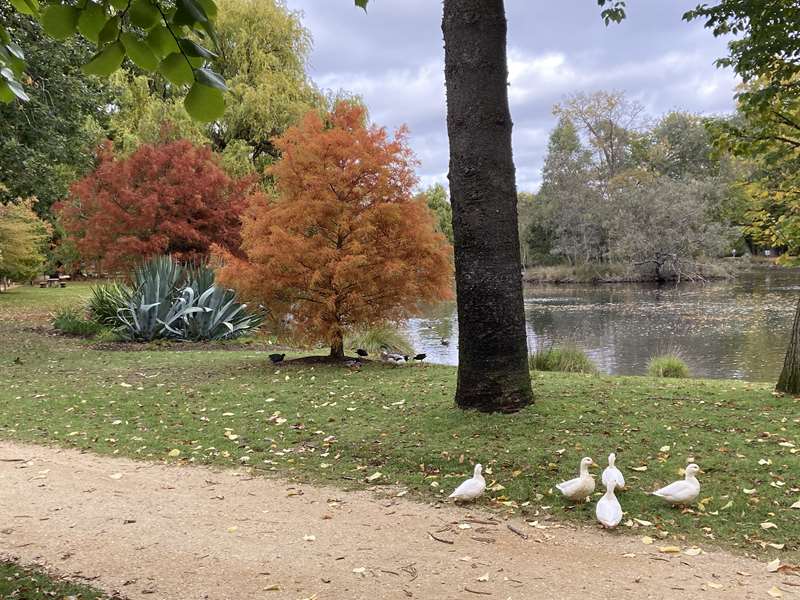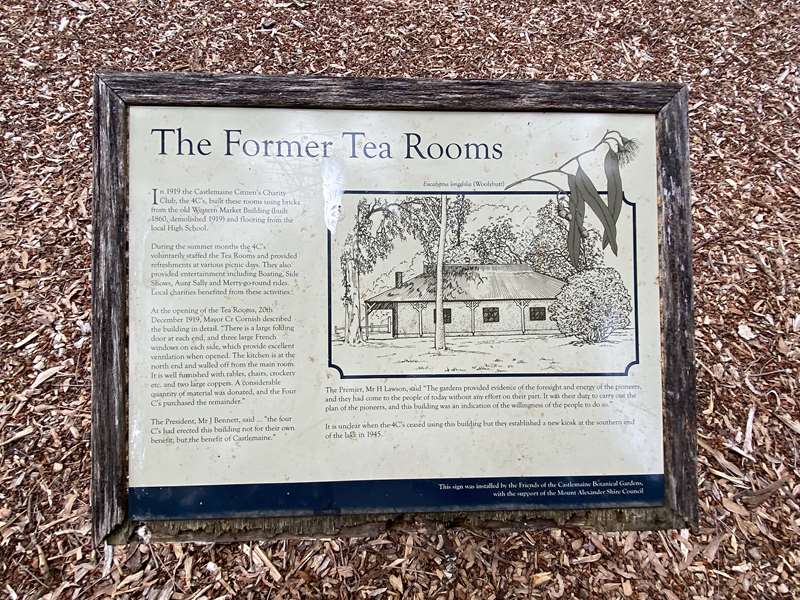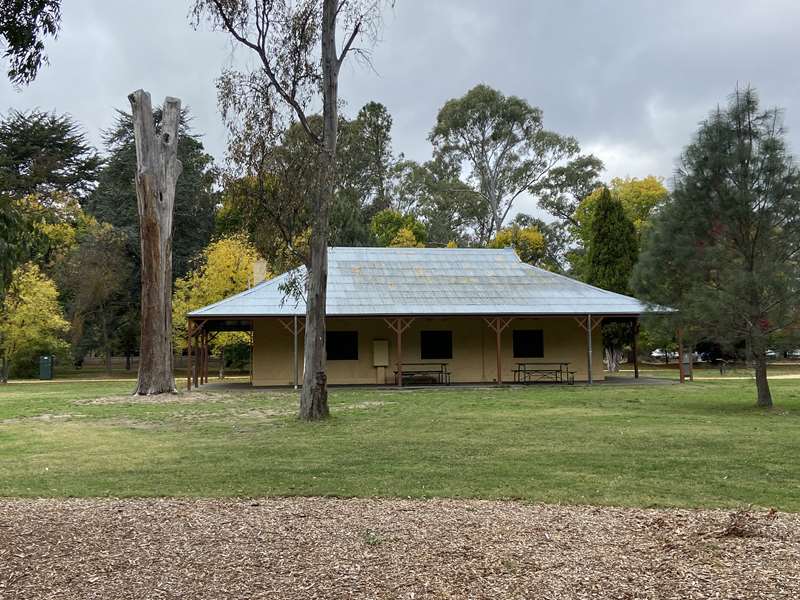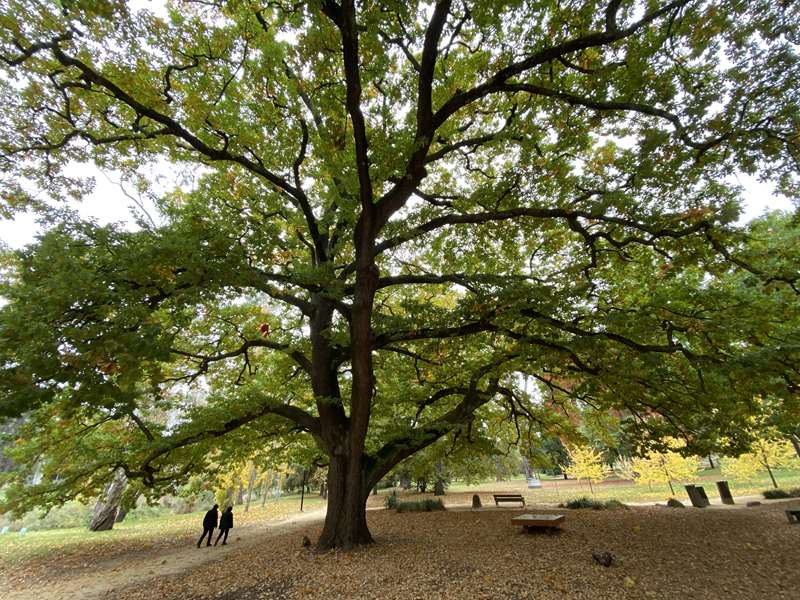Castlemaine Botanical Gardens


Wander through this 19th Century garden and discover the many original features including the carriage drive, elm and oak avenues, Lake Joanna, and the formal garden beds that contrast with lush open lawns.
The gardens have undergone a multi-million dollar refurbishment, including improvements to the garden's lake, amenities, parking and installation of a new playground and picnic facilities.

History - In 1860, 25 hectares of heavily-worked diggings alongside Barkers Creek were set aside for botanic gardens. In 1866 the council appointed Philip Doran as the first curator, a role he fulfilled until his death in 1913 at the age of 83. The gardens essentially retain his original design and major plantings.
Trees - The gardens are home to an impressive collection of native and exotic trees, some of which are registered with the National Trust. They include a huge English Oak which was planted by the Duke of Edinburgh in 1867.
The Former Tea Rooms

In 1919 the Castlemaine Citizen's Charity Club, the 4C's, built these rooms using bricks from the old Western Market Building (built 1860, demolished 1919) and flooring from the local High School.
During the summer months the 4C's voluntarily staffed the Tea Rooms and provided refreshments at various picnic days. They also provided entertainment including Boating, Side Shows, Aunt Sally and Merry-go-round rides. Local charities benefited from these activities.

At the opening of the Tea Rooms, 20th December 1919, Mayor Cr Cornish described the building in detail. "There is a large folding door at each end, and three large French windows on each side, which provide excellent ventilation when opened. The kitchen is at the north end and walled off from the main room. It is well furnished with tables, chairs, crockery etc. and two large coppers. A considerable quantity of material was donated, and the Four C's purchased the remainder."
The President, Mr J Bennett, said ... "the four C's had erected this building not for their own benefit, but for the benefit of Castlemaine."
The Premier, Mr H Lawson, said "The gardens provided evidence of the foresight and energy of the pioneers, and they had come to the people of today without any effort on their part. It was their duty to carry out the plan of the pioneers, and this building was an indication of the willingness of the people to do so."
It is unclear when the 4C's ceased using this building but they established a new kiosk at the southern end of the lake in 1945.
Historic Oak Tree

This oak tree was planted on 26th May 1863 to celebrate the marriage of the Prince and Princess of Wales. It is the oldest existing planting in the Castlemaine Botanical Gardens.
The Summerhouse

This is a reconstruction of the original Summerhouse, built on this site in 1872.
At the September 1872 meeting of the Council, the Gardens' Curator, Philip Doran, recommended 'that a place be erected for shelter in case of rain.'
In 1993, the Friends of the Castlemaine Botanical Gardens decided to reconstruct the Summerhouse,
and embarked on fundraising over a number of years.
The new structure was built in modules in Bendigo by the Bendigo Regional Institute of TAFE building trainees and then transported to Castlemaine and assembled here in July 2000.
Plans were drawn up based on an early photograph.
The Fountain

Early in 1878, the Council decided to erect a fountain in the vicinity of the entrance to the Gardens. From a book of nineteen designs, one was selected and the construction was undertaken soon after.
By the early 1880s the area was landscaped with box hedging lining formal pathways and roses planted in beds. In late 1918, the surrounding area was built up with soil from the creek and the hedging and rose pillars were removed. In January 1919, the Mount Alexander Mail reported that the "fountain has been renovated and replaced in good working order, with water lilies at the base, with a bed of salvia bonfires around the fountain as part of a concerted redesign of beds at the south eastern entrance by the Curator, Mr Williams."
A major restoration of the fountain and of the surrounding landscape took place in 2011. The area has been returned to a condition that is close to the original layout of the late 1800s. Due to extensive metal corrosion, the metal fountain was almost fully re-cast based on the original mould.
Review:
The Gardens have a lovely https://www.melbourneplaygrounds.com.au/castlemaine-botanic-gardens-play-space-cnr-froomes-rd-and-downes-rd-castlemaine">playground in the north east corner, a lake with water birds, plenty of interesting trees, flower beds, bird bath, fountain, sundial and historic buildings.

There are shaded and unshaded seats and tables throughout the gardens and water taps and toilets at both ends.
Buildings in the gardens include a reconstruction of the original Summerhouse built on the site in 1872 and the former Tea Rooms which is available to the public for community and family events and is home to the Castlemaine Highland Pipe Band.
A gravel path runs along one side of the gardens and Barkers Creek runs along the west side. The centrepiece is Lake Joanna which was dug out by teams of prisoners from the Castlemaine Gaol in the late 1870s. Unfortunately the lake is not suitable for swimming.
It is possible to take a 10 minute walk from the south end of the gardens to the Castlemaine Railway Station or a slightly longer 15 minute walk to the old Gaol. Follow the signage bollards along Gingell Street.
Photos:
Location
Cnr Froomes Road and Downes Road, Castlemaine 3450 Map
Web Links
→ Castlemaine Botanical Gardens Walk (Walking Maps)
→ Castlemaine Botanical Gardens Significant Trees Walk









